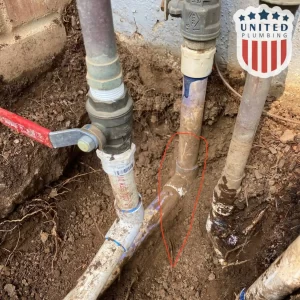Sewer Line Repairs: What You Need to Know
Your home’s sewer line is a crucial part of its plumbing system, responsible for whisking away wastewater from your property. But like anything else, sewer lines can face problems over time due to aging, tree roots, corrosion, and more. When these issues rear their heads, it’s important to grasp the different repair methods available. In this article, we’ll give you an overview of these methods and introduce United Plumbing, experts in the field who can help you tackle sewer line problems.
1. Traditional Dig-and-Replace Method:
When Things Get Serious, Dig Deep
Imagine excavating the damaged part of your sewer line and replacing it with new pipes. While this method works, it can be a real headache and a wallet-squeezer due to all the digging. Still, it’s necessary when damage is severe or the whole line needs a facelift. Here’s what you should know:
Digging: Trenches are dug to access the damaged pipe, which can mess up your landscaping and necessitate further repairs.
Durability: New pipes used in the replacement are usually built to last, made of materials like PVC or HDPE, ensuring a long, trouble-free life.
Professional Touch: This method requires expert plumbing skills and equipment.


2. Trenchless Sewer Repair:
Less Mess, More Efficiency
Trenchless sewer repair methods have gained popularity due to their minimal disruption and efficiency. Two commonly used techniques are:
Pipe Lining:
Imagine sliding a flexible, resin-coated tube into the damaged sewer pipe. The resin hardens, creating a durable inner lining. This is great for cracks, small leaks, and minor deterioration.
- Minimal: No need for extensive excavation, saving your property from unnecDisruptionessary damage.
- Cost-Effective: Often, pipe lining is kinder to your wallet compared to traditional methods.
- Speed: Repairs are typically done quicker than traditional methods.

Pipe Bursting:
Consider breaking the old, damaged pipe while simultaneously pulling in a new one. This works wonders when you need to replace severely damaged pipes.
- No Digging: Minimal excavation is required, making it less disruptive than traditional methods.
- Efficiency: Pipe bursting allows for efficient replacement with new, sturdy pipes.
- Longevity: The new pipe is typically made of high-density polyethylene (HDPE), which resists corrosion and tree root intrusion.

3. Chemical Sewer Line Repair:
Quick Fixes for Minor Hassles
For minor leaks and cracks, chemical sewer line repair methods use specialized chemicals. These treatments offer immediate relief but may not be a long-term solution for significant damage.
Quick Fixes: These treatments can temporarily seal minor leaks, offering immediate relief.
Affordability: Often, chemical treatments are cost-effective for minor repairs.
Temporary Solution: They might not address the root cause and may require repeated treatments.
4. Mechanical Cleaning and Snaking:
Battle Minor Clogs with Machines
When it comes to minor clogs and blockages due to debris or tree roots, mechanical cleaning and snaking can be your knights in shining armor. This involves using specialized equipment to clear obstructions in the sewer line.

Cost-Effective: Mechanical cleaning doesn’t break the bank and can quickly clear blockages.
Maintenance: Regular snaking can help prevent future blockages and maintain sewer line functionality.
In Conclusion:
Choosing the right sewer line repair method depends on damage severity, budget, and how much disruption you can tolerate. For minor issues, consider trenchless methods like pipe lining or mechanical cleaning. However, for extensive damage or complete replacement, traditional dig-and-replace or trenchless pipe bursting might be necessary. Always consult with United Plumbing, experts in this field, to assess your sewer line’s condition and find the best repair technique for your situation. Timely repairs and proper maintenance ensure the longevity and functionality of your home’s sewer system.
Post views: 533

